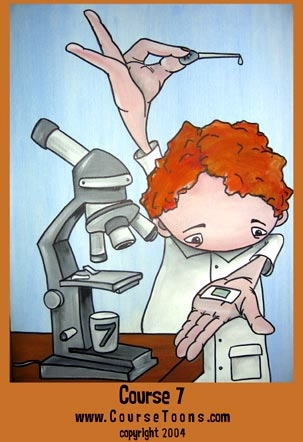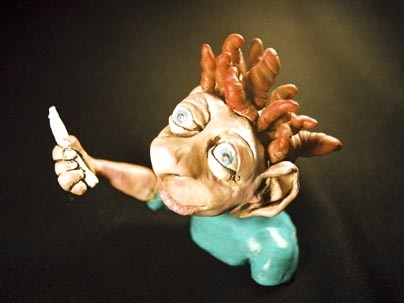The winners of this year's Harold and Arlene Schnitzer Prize in the Visual Arts drew inspiration from trick-or-treating, cornfields, MIT courses and ketchup.
About 20 artists competed for the prizes, which reward excellence in a body of work. First prize, $1,500, went to architecture graduate student Luis Berrios-Negron.
Berrios-Negron will exhibit his video, installation and photography at the Wiesner Student Art Gallery on the second floor of the Stratton Student Center in September. A sampling of the other winners' works is on view there now through June 20. The gallery is open 24 hours a day.
Media arts and sciences graduate student Andrew "Zoz" Brooks won second prize, $900, for video, sculpture and agitprop. In his artist's statement, Brooks says he aims to "twist around things that are intimately familiar ��� to encourage people to think in new ways about events and rituals." His exhibited works include a series of videos that confront and subvert such traditions as trick-or-treating, religious holiday observances and broadcast television.
"My intention is primarily to wrestle with things that interest me," Brooks wrote. "I hope to inspire [others] to think about their experiences with a distorted perspective."
In one work, "Protest Flags," Brooks dyed American flags and added provocative slogans to convey what he calls "a very different and unfamiliar visual impression of these well-known icons."
Brooks' "Steer Roast Shield" serves as a functional symbol for Senior Haus' annual Steer Roast. The stainless steel shield acts as a weight for the traditional ignition system of lighted toilet paper, Brooks says, descending down a wire from the roof to the steer roast pit in the dorm courtyard. Left to burn overnight, the shield rises phoenixlike from the ashes, essentially unmarred, Brooks says.
The third prize of $600 went to architecture senior Cecilia Ramos for her oil landscape paintings of the Midwest. Cecilia Ramos says she found her inspiration far off-campus, on a plane flying into St. Louis. "The vast expanse of America's Midwest landscape is tremendous, awe inspiring and sublime," she wrote in her statement, explaining how she spent June and July 2004 in the cornfields of southern Illinois, devoted to "the landscape and to my paints, striving to experience, understand, grasp and depict the immensity as well as the subtleties of the landscape through intense explorations on canvas."
Ramos used what she calls intense layering of colors, textures, brush strokes and forms to try to capture the power of the land.
"I believe that immersion is the perfect word to describe this painting series and the overall experience," she says about being alone in the cornfields with her easel, canvas and paints. With the wind often toppling her easel and insects frequently landing on her canvas, "nature continued its everyday course, unaware of my presence and without regard for my art project," she wrote.
Mechanical engineering graduate student Barry Kudrowitz received an honorable mention for illustration, sculpture and "unuseless invention."
The exhibition includes a collection of Kudrowitz's "CourseToons," lighthearted illustrations in acrylic on canvas of the courses available at MIT. "CourseToons," Kudrowitz says, "serve as a means to promote the fun side of MIT��� through quirky representations of the majors."
Kudrowitz has also created small sculptures such as "Sleepy Girl" and "Arnold Soft," using Super Sculpey, a sculpting compound. "Arnold Soft" is a model created for an illustration for Kudrowitz's "The Enchanted Poetry of Arnold Soft," which tells the story of a boy who uses his ability to turn poetry into reality to save his kidnapped grandmother.
Also on view is the "Catsup Crapper," for which Kudrowitz won first place with fellow mechanical engineering graduate students Bill Fienup and Marc Graham in the MIT Unuseless Competition. Visitors to the Schnitzer exhibition can see what the artists call "the first ketchup bottle to roller-skate to your plate and excrete a pleasant mound of condiment," even if they can't actually try it out in the adjacent Lobdell Dining Hall.
The Schnitzer Prize was established in 1996 by the Student Art Association through an endowment from Harold and Arlene Schnitzer of Portland, Ore. Schnitzer, a real estate investor, graduated from MIT in 1944 with a degree in metallurgy.
A version of this article appeared in MIT Tech Talk on June 8, 2005 (download PDF).








